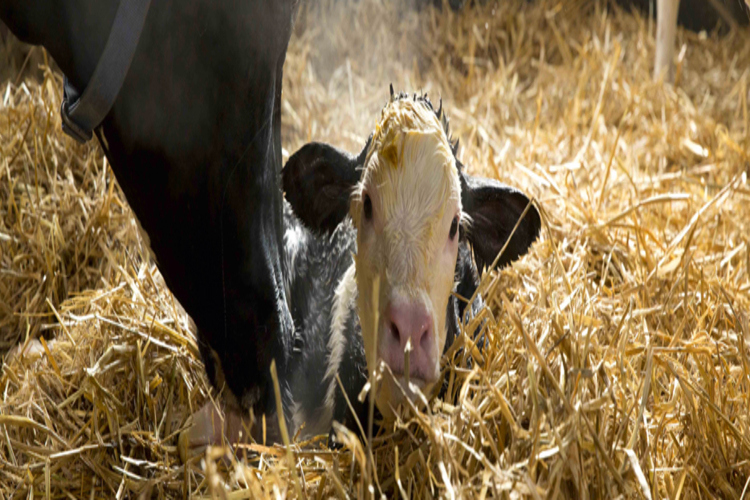Key takeaways from the research:
-
Colostrum is crucial for neonatal calves to obtain passive immunity while they develop their own immunity.
-
Other factors in colostrum are also important for the health and vitality of dairy calves.
-
Non-nutrient factors in colostrum such as IGF-1, insulin and relaxin have been shown to improve reproductive performance and feed efficiency.
-
A good colostrum protocol for neonatal calves is essential for optimal health, vitality and performance.

Colostrum contains growth factors that improve immunity, feed efficiency and reproductive performance
Optimal colostrum management is perhaps the single most important factor that affects the health and vitality of neonatal calves. Calves are born without immunoglobulins in their circulation and they do not have an immunological memory. Transfer of immunoglobulins from colostrum should take place while the gut wall is open to macromolecular transport. Passive immunity acquired during this time helps to protect the calf from pathogens during their first few days of life while their immune system starts to develop. While the transfer of Ig's is vitally important, colostrum is also rich in essential nutrients that the calf needs in its first few hours of life, for both growth and maintenance. In their abstract called "A Brief Review of the Developmental Role of Colostrum in Neonates"[1], Van Amburgh and Lopez explained the lactocrine hypothesis and discussed the role of colostrum in fostering long-term productivity and feed efficiency via factors other than immunoglobulins.
The lactocrine hypothesis
The lactocrine hypothesis suggests that certain growth factors and hormones in mammary secretions that are present in colostrum and milk have an impact on young mammals. Data from several species suggest that neonates can be programmed after birth leading to a modification of developmental functions. In calves, increasing nutrient intake from milk prior to weaning has resulted in increased milk yield during first lactation[2]. While this seems to be the result of increased nutrient intake resulting in an increase in pre-weaning growth rate, there may also be additional effects from signals produced by growth factors and hormones present in colostrum.
The role of colostrum
While the exact mechanisms by which colostrum has long-term effects on the development of the gastrointestinal tract are still not well understood, it are the non-nutrient factors in colostrum that may play a major role. Molecules such as IGF-1 and insulin have been shown to increase the rate of protein synthesis in piglets.[3] Likewise, milk-borne relaxin concentrations have been shown to improve reproductive performance in piglets later in life as well.[4] In calves, those fed maternal colostrum instead of serum-derived colostrum replacers (which provide immunoglobulins but do not contain the other bioactive factors that maternal colostrum contains) had a significantly higher feed efficiency,[5] suggesting that factors other than colostrum derived antibodies contributed to these effects. In another calf study, those fed four litres of colostrum compared to those fed two litres, prior to ad libitum milk replacer intake pre-weaning, had average daily gains that were significantly higher both pre-and post-weaning.[6] Thus, if colostrum contributes to feeding efficiency changes, it can be postulated that the first feeding can affect the future milk production of dairy cows.[7]
In calves, glucose absorption capacity is enhanced and plasma glucose concentrations are also considerably higher when they are colostrum-fed as opposed to being formula-fed.[8] If these differences in glucose metabolism were to persist, it could help researchers to understand the effects of colostrum beyond immunoglobulins on long-term productivity.
Knowing that certain hormones and growth factors in colostrum spur long-term productivity and enhance dairy calf feed efficiency, it is even more important that on-farm colostrum protocols are in place and up-to-date!
References
[1] Van Amburgh, M.E.; Lopez, D. J. (2012). A Brief Review of the Developmental Role of Colostrum in Neonates. Retrieved from the University of Minnesota Digital Conservancy,
[2] Soberon F, E. Raffrenato, R.W. Everett and M.E. Van Amburgh. 2012. Early life milk replacer intake and effects on long term productivity of dairy calves. J. Dairy Sci. 95:783–793.
[3] Burrin, D. G., T. A. Davis, S. Ebner, P. A. Schoknect, M. L. Fiorotto, P. J. Reeds, and S. McAvoy. 1995. Nutrient-independent and nutrient-dependent factors stimulate protein synthesis in colostrum-fed newborn pigs. Pediatr. Res. 37:593-599.
[4] Bartol, F. F., A. A. Wiley, and C. A. Bagnell. 2008. Epigenetic programming of porcine endometrial function and the lactocrine hypothesis. Reprod. Domest. Anim. 43:273-279.
[5] Jones, C. M., R. E. James, J. D. Quiqley, III, and M. L. McGilliard. 2004. Influence of pooled colostrum or colostrum replacement on IgG and evaluation of animal plasma in milk replacer. J. Dairy Sci. 87:1806-1814.
[6] Soberon F., and M. E. Van Amburgh. 2011. Effects of colostrum intake and pre-weaning nutrient intake on post-weaning feed efficiency and voluntary feed intake. J. Dairy Sci. 94:69-70 (Abstr.).
[7] Van Amburgh, M.E.; Lopez, D. J. (2012). Op cit.
[8] Steinhoff-Wagner, J., S. Görs, P. Junghans, R. M. Bruckmaier, E. Kanitz, C. C. Metges, and H. M. Hammon. 2011. Intestinal glucose absorption but not endogenous glucose production differs between colostrum- and formula-fed neonatal calves. J. Nutr. 141:48-55.



